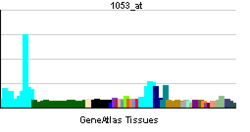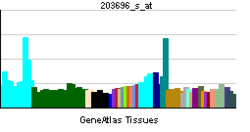RFC2
Replication factor C subunit 2 is a protein that in humans is encoded by the RFC2 gene.[1][2][3]
The elongation of primed DNA templates by DNA polymerase delta and epsilon requires the action of the accessory proteins, proliferating cell nuclear antigen (PCNA) and replication factor C (RFC). RFC, also called activator 1, is a protein complex consisting of five distinct subunits of 145, 40, 38, 37, and 36.5 kD. This gene encodes the 40 kD subunit, which has been shown to be responsible for binding ATP. Deletion of this gene has been associated with Williams syndrome. Alternatively spliced transcript variants encoding distinct isoforms have been described.[3]
Interactions
RFC2 has been shown to interact with BRD4,[4] CHTF18,[5][6] PCNA,[7][8][9] RFC4[7][10] and RFC5.[7][10]
References
- ↑ Chen M, Pan ZQ, Hurwitz J (May 1992). "Sequence and expression in Escherichia coli of the 40-kDa subunit of activator 1 (replication factor C) of HeLa cells". Proc Natl Acad Sci U S A 89 (7): 2516–20. doi:10.1073/pnas.89.7.2516. PMC 48692. PMID 1313560.
- ↑ Okumura K, Nogami M, Taguchi H, Dean FB, Chen M, Pan ZQ, Hurwitz J, Shiratori A, Murakami Y, Ozawa K et al. (Jul 1995). "Assignment of the 36.5-kDa (RFC5), 37-kDa (RFC4), 38-kDa (RFC3), and 40-kDa (RFC2) subunit genes of human replication factor C to chromosome bands 12q24.2-q24.3, 3q27, 13q12.3-q13, and 7q11.23". Genomics 25 (1): 274–8. doi:10.1016/0888-7543(95)80135-9. PMID 7774928.
- ↑ 3.0 3.1 "Entrez Gene: RFC2 replication factor C (activator 1) 2, 40kDa".
- ↑ Maruyama, Tetsuo; Farina Andrea; Dey Anup; Cheong JaeHun; Bermudez Vladimir P; Tamura Tomohiko; Sciortino Selvaggia; Shuman Jon; Hurwitz Jerard; Ozato Keiko (Sep 2002). "A Mammalian bromodomain protein, brd4, interacts with replication factor C and inhibits progression to S phase". Mol. Cell. Biol. (United States) 22 (18): 6509–20. doi:10.1128/MCB.22.18.6509-6520.2002. ISSN 0270-7306. PMC 135621. PMID 12192049.
- ↑ Bermudez, Vladimir P; Maniwa Yoshimasa; Tappin Inger; Ozato Keiko; Yokomori Kyoko; Hurwitz Jerard (Sep 2003). "The alternative Ctf18-Dcc1-Ctf8-replication factor C complex required for sister chromatid cohesion loads proliferating cell nuclear antigen onto DNA". Proc. Natl. Acad. Sci. U.S.A. (United States) 100 (18): 10237–42. doi:10.1073/pnas.1434308100. ISSN 0027-8424. PMC 193545. PMID 12930902.
- ↑ Merkle, Carolin J; Karnitz Larry M, Henry-Sánchez John T, Chen Junjie (Aug 2003). "Cloning and characterization of hCTF18, hCTF8, and hDCC1. Human homologs of a Saccharomyces cerevisiae complex involved in sister chromatid cohesion establishment". J. Biol. Chem. (United States) 278 (32): 30051–6. doi:10.1074/jbc.M211591200. ISSN 0021-9258. PMID 12766176.
- ↑ 7.0 7.1 7.2 Cai, J; Gibbs E; Uhlmann F; Phillips B; Yao N; O'Donnell M; Hurwitz J (Jul 1997). "A complex consisting of human replication factor C p40, p37, and p36 subunits is a DNA-dependent ATPase and an intermediate in the assembly of the holoenzyme". J. Biol. Chem. (UNITED STATES) 272 (30): 18974–81. doi:10.1074/jbc.272.30.18974. ISSN 0021-9258. PMID 9228079.
- ↑ Pan, Z Q; Chen M; Hurwitz J (Jan 1993). "The subunits of activator 1 (replication factor C) carry out multiple functions essential for proliferating-cell nuclear antigen-dependent DNA synthesis". Proc. Natl. Acad. Sci. U.S.A. (UNITED STATES) 90 (1): 6–10. doi:10.1073/pnas.90.1.6. ISSN 0027-8424. PMC 45588. PMID 8093561.
- ↑ Ohta, Satoshi; Shiomi Yasushi; Sugimoto Katsunori; Obuse Chikashi; Tsurimoto Toshiki (Oct 2002). "A proteomics approach to identify proliferating cell nuclear antigen (PCNA)-binding proteins in human cell lysates. Identification of the human CHL12/RFCs2-5 complex as a novel PCNA-binding protein". J. Biol. Chem. (United States) 277 (43): 40362–7. doi:10.1074/jbc.M206194200. ISSN 0021-9258. PMID 12171929.
- ↑ 10.0 10.1 Cai, J; Yao N; Gibbs E; Finkelstein J; Phillips B; O'Donnell M; Hurwitz J (Sep 1998). "ATP hydrolysis catalyzed by human replication factor C requires participation of multiple subunits". Proc. Natl. Acad. Sci. U.S.A. (UNITED STATES) 95 (20): 11607–12. doi:10.1073/pnas.95.20.11607. ISSN 0027-8424. PMC 21688. PMID 9751713.
Further reading
- Pan ZQ, Chen M, Hurwitz J (1993). "The subunits of activator 1 (replication factor C) carry out multiple functions essential for proliferating-cell nuclear antigen-dependent DNA synthesis.". Proc. Natl. Acad. Sci. U.S.A. 90 (1): 6–10. doi:10.1073/pnas.90.1.6. PMC 45588. PMID 8093561.
- Peoples R, Perez-Jurado L, Wang YK et al. (1996). "The gene for replication factor C subunit 2 (RFC2) is within the 7q11.23 Williams syndrome deletion.". Am. J. Hum. Genet. 58 (6): 1370–3. PMC 1915059. PMID 8651315.
- Uhlmann F, Cai J, Flores-Rozas H et al. (1996). "In vitro reconstitution of human replication factor C from its five subunits.". Proc. Natl. Acad. Sci. U.S.A. 93 (13): 6521–6. doi:10.1073/pnas.93.13.6521. PMC 39056. PMID 8692848.
- Osborne LR, Martindale D, Scherer SW et al. (1997). "Identification of genes from a 500-kb region at 7q11.23 that is commonly deleted in Williams syndrome patients.". Genomics 36 (2): 328–36. doi:10.1006/geno.1996.0469. PMID 8812460.
- Cujec TP, Cho H, Maldonado E et al. (1997). "The human immunodeficiency virus transactivator Tat interacts with the RNA polymerase II holoenzyme.". Mol. Cell. Biol. 17 (4): 1817–23. PMC 232028. PMID 9121429.
- Cai J, Gibbs E, Uhlmann F et al. (1997). "A complex consisting of human replication factor C p40, p37, and p36 subunits is a DNA-dependent ATPase and an intermediate in the assembly of the holoenzyme.". J. Biol. Chem. 272 (30): 18974–81. doi:10.1074/jbc.272.30.18974. PMID 9228079.
- Ellison V, Stillman B (1998). "Reconstitution of recombinant human replication factor C (RFC) and identification of an RFC subcomplex possessing DNA-dependent ATPase activity.". J. Biol. Chem. 273 (10): 5979–87. doi:10.1074/jbc.273.10.5979. PMID 9488738.
- Zhang G, Gibbs E, Kelman Z et al. (1999). "Studies on the interactions between human replication factor C and human proliferating cell nuclear antigen.". Proc. Natl. Acad. Sci. U.S.A. 96 (5): 1869–74. doi:10.1073/pnas.96.5.1869. PMC 26703. PMID 10051561.
- Wang Y, Cortez D, Yazdi P et al. (2000). "BASC, a super complex of BRCA1-associated proteins involved in the recognition and repair of aberrant DNA structures.". Genes Dev. 14 (8): 927–39. PMC 316544. PMID 10783165.
- Martindale DW, Wilson MD, Wang D et al. (2000). "Comparative genomic sequence analysis of the Williams syndrome region (LIMK1-RFC2) of human chromosome 7q11.23.". Mamm. Genome 11 (10): 890–8. doi:10.1007/s003350010166. PMID 11003705.
- Griffith JD, Lindsey-Boltz LA, Sancar A (2002). "Structures of the human Rad17-replication factor C and checkpoint Rad 9-1-1 complexes visualized by glycerol spray/low voltage microscopy.". J. Biol. Chem. 277 (18): 15233–6. doi:10.1074/jbc.C200129200. PMID 11907025.
- Nieborowska-Skorska M, Hoser G, Kossev P et al. (2002). "Complementary functions of the antiapoptotic protein A1 and serine/threonine kinase pim-1 in the BCR/ABL-mediated leukemogenesis.". Blood 99 (12): 4531–9. doi:10.1182/blood.V99.12.4531. PMID 12036885.
- Ohta S, Shiomi Y, Sugimoto K et al. (2002). "A proteomics approach to identify proliferating cell nuclear antigen (PCNA)-binding proteins in human cell lysates. Identification of the human CHL12/RFCs2-5 complex as a novel PCNA-binding protein.". J. Biol. Chem. 277 (43): 40362–7. doi:10.1074/jbc.M206194200. PMID 12171929.
- Maruyama T, Farina A, Dey A et al. (2002). "A Mammalian bromodomain protein, brd4, interacts with replication factor C and inhibits progression to S phase.". Mol. Cell. Biol. 22 (18): 6509–20. doi:10.1128/MCB.22.18.6509-6520.2002. PMC 135621. PMID 12192049.
- Strausberg RL, Feingold EA, Grouse LH et al. (2003). "Generation and initial analysis of more than 15,000 full-length human and mouse cDNA sequences.". Proc. Natl. Acad. Sci. U.S.A. 99 (26): 16899–903. doi:10.1073/pnas.242603899. PMC 139241. PMID 12477932.
- Merkle CJ, Karnitz LM, Henry-Sánchez JT, Chen J (2003). "Cloning and characterization of hCTF18, hCTF8, and hDCC1. Human homologs of a Saccharomyces cerevisiae complex involved in sister chromatid cohesion establishment.". J. Biol. Chem. 278 (32): 30051–6. doi:10.1074/jbc.M211591200. PMID 12766176.
- Hillier LW, Fulton RS, Fulton LA et al. (2003). "The DNA sequence of human chromosome 7.". Nature 424 (6945): 157–64. doi:10.1038/nature01782. PMID 12853948.
- Bermudez VP, Maniwa Y, Tappin I et al. (2003). "The alternative Ctf18-Dcc1-Ctf8-replication factor C complex required for sister chromatid cohesion loads proliferating cell nuclear antigen onto DNA.". Proc. Natl. Acad. Sci. U.S.A. 100 (18): 10237–42. doi:10.1073/pnas.1434308100. PMC 193545. PMID 12930902.

